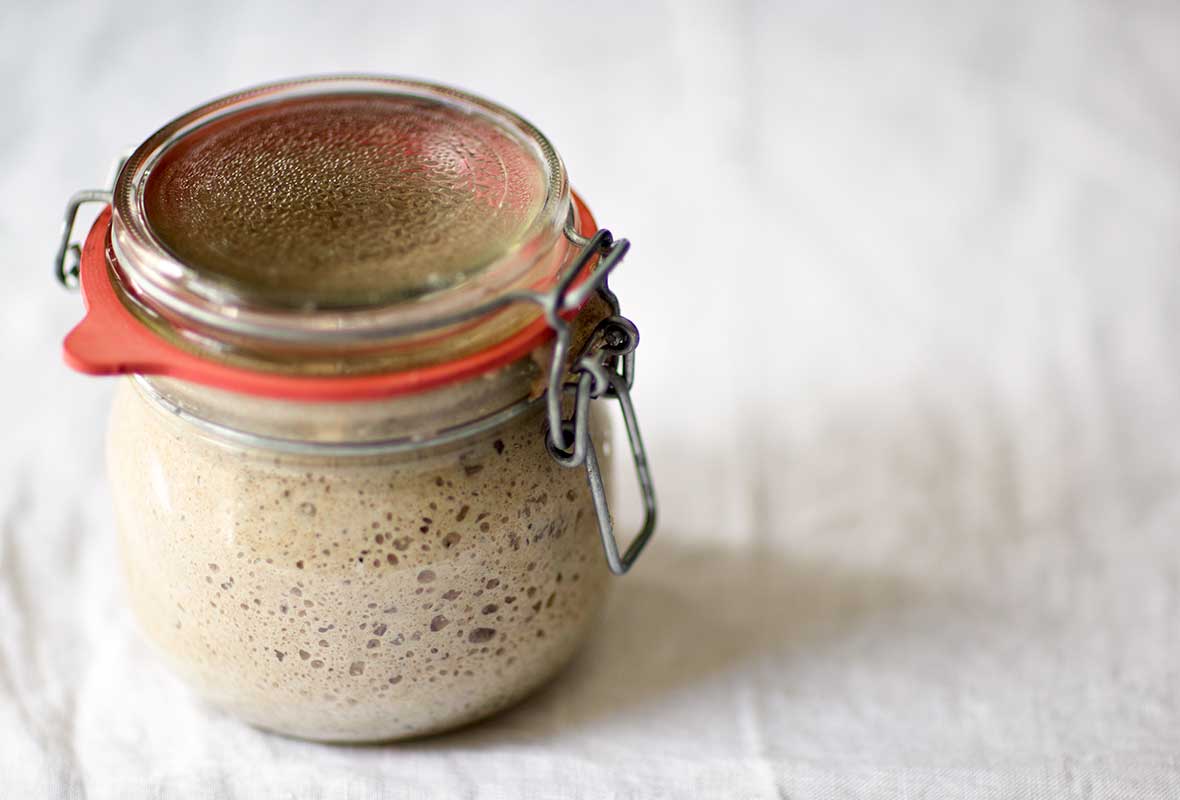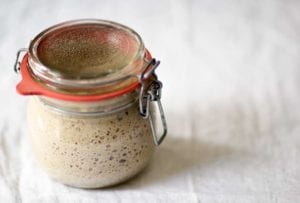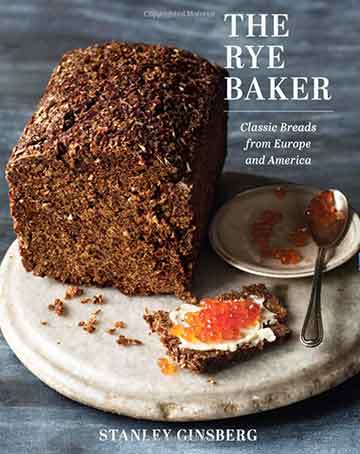
It’s not hard to make a rye sourdough starter from scratch. Some sourdough starters rely on wild yeasts that live in the air, others on acid-producing bacteria present in buttermilk, yogurt, pineapple juice, and the like, and still others start with commercial yeast or store-bought starters. Fact is, none of these additives is necessary. All it really takes to build a delicious and robust rye sour culture, or starter, is some whole-grain rye flour, water, a warm place, and patience. [Editor’s Note: And when your traditional rye sourdough starter is complete, the very first thing you’re going to want to do is use it to make this Galician rye bread.]–Stanley Ginsberg
☞ LEARN MORE, READ: HOW TO DRY SOURDOUGH STARTER

Rye Sourdough Starter
Ingredients
Day 1: Make the Rye Sourdough Starter
- 2.5 ounces whole grain rye flour, preferably organic
- 2.5 ounces warm water (105°F or 41°C)
Days 2 to 7: Refresh the Rye Sourdough Starter
- 2.5 ounces whole grain rye flour, preferably organic
- 2.5 ounces warm water (105°F or 41°C)
- 2.5 ounces Sour Starter from the preceding day
Days 8 and Beyond: Maintain the Rye Sourdough Starter
- 2.5 ounces medium or whole-grain rye flour, preferably organic
- 2.5 ounces warm water (105°F or 41°C)
- .25 ounces rye sourdough starter
Instructions
Day 1: Make the rye sourdough starter
- Start with equal amounts of organic rye flour and water by weight. Dump them in a nonreactive (glass, porcelain, stainless-steel, plastic) container, mix by hand into a stiff paste, cover, and let stand at room temperature (68 to 72°F or 20 to 22°C) for 24 hours.
☞ TESTER TIP: Occasionally the yeast normally present in whole grains fail to establish itself in a new culture; if, after 3 or 4 days, the culture darkens, develops a mold, or smells bad, dump the whole batch and start over. After a week, the culture, or sourdough starter, will be ready to use or to be stored refrigerated in an airtight container for a couple days. [Editor's Note: If storing the sourdough starter for more than a couple days, you'll need to maintain it, which we explain how to do just below.]
Days 2 to 7: Refresh the rye sourdough starter
- The next day, discard all but 2 1/2 ounces (70 grams) of the culture and mix the remainder with the refresh ingredients, cover, and let stand. Repeat each day, discarding all but 2 1/2 ounces (70 grams) of the preceding day’s culture.
☞ TESTER TIP: The most important point to remember at the early stages is to feed the sourdough starter daily. Even when it shows no apparent fermentation, the yeast is busy multiplying and consuming nutrients at a very high rate. By the second or third day, it will swell, show bubbles, and give off a clean sour smell. Over the next few days the activity will become more and more vigorous and the smell more intense.
Days 8 and Beyond: Maintain the rye sourdough starter
- In a perfect world—or in a working bakery—sourdough starters are refreshed daily. That said, daily feedings demand both a degree of dedication and abundant flour supplies that are impractical for all but the most committed home bakers. You can get by refreshing your starter every 36 hours or so.
- Mix the rye flour, water, and rye sourdough starter by hand until incorporated. Cover and ferment at room temperature (68 to 72°F or 20 to 22°C) overnight or for 10 to 12 hours. The sponge will be very bubbly, have a clean sour smell, and will have tripled in volume. Store refrigerated in an airtight container and it will last indefinitely.

Nutrition
Nutrition information is automatically calculated, so should only be used as an approximation.
Recipe Testers’ Reviews
The rye starter was easy to make and quick. It took about 5 minutes each of the 7 days. Mine smelled great and seemed consistent after the week of feedings. I switched to the refresh amounts after that and it stayed nice and healthy.
During the buildup, you end up tossing about 2/3 of it away. I definitely recommend a scale versus just using volume measurements.










I’m so confused about my starter. The first 2 days it was rising beautifully and things were going great but the last 2 days there’s basically no growth at all. I didn’t change anything, it sits in the same place, I used the same measurements. I don’t know whats going wrong.
Joel, I feel your pain. I’ve had the same thing happened to some of my starters while others take off like a shot. I’ve consulted many sourdough experts over the course of the lockdown, while so many people are making bread, and the common refrain is: give it time. When asked how long does it really take for a starter to get moving, the answers ranged from seven days to three weeks. It truly depends so much upon the environment, the bacteria and natural yeast in the air, ambient temperature, etc.
So, if you can hang in there, please do. I think you will be rewarded with a marvelous cooking buddy.
Hi David! I just started my starter today after trying to use part of a friend’s and not seeing results I felt were right. I have a few questions:
1. We feed the starter once it has deflated right? what if it is deflated for more than 12 hours?
2. what is pre-ferment?
3. What does the starter look like when it’s ready to make bread with it? i saw you say “when it is its biggest” – how do we know when it’s its biggest?
4. I don’t have that much rye flour, so I am using 50g of flour and water for the initial and each subsequent feeding. is this ok?
5. Once I am ready to start storing it in the refrigerator, should I do weekly feedings or is this not necessary? if I do feed it while it lays dormant in the fridge, do I just feed it (50 g water & flour) and then put it right back in the fridge? it can still eat in the cold fridge?
THANK YOU SO MUCH!
Charlotte,
1. Feed the start of every 24 hours. At least initially.
2. I pre-ferment is anything that’s added to a bread recipe to make it rise, such as sourdough starter, biga, poolish, etc. So this recipe is a pre-ferment.
3. Sure, that’s OK.
4. You can feed it once a week after it’s mature. I let it sit out so that it does it’s munching at room temperature. And then put it back in the fridge.
I’ve been trying to grow my own stater for a number of weeks….tired with unbleached flour….did not have success…tried with whole wheat flour and too did not have success. I was hesitant to try again especially with all the past flour that I did not end up using.
I came across your recipe and thought ok…let me try one more time using rye flour. Picked up some rye from my local store and started yesterday afternoon. Day 1 was complex this afternoon and let me tell you it doubled in size with lots of air bubbles in just 24 hrs! I couldn’t believe what I was seeing! Gave it another feed and 6hrs later not only did it doubled more again, beautiful air bubbles. So happy to see positive results! I do have a couple of questions as I go on that I am hoping you can help.
1. Can I dry the discard and save for a later time? I feel terrible wasting it and know that I won’t be baking with it.
2. My 24hr feedings is at 2:30pm. Day 7 with be on a Friday, which I will feed at 2:30pm. How does the process work in terms of know when to starter the process to make the bread? How long after the 7th feeding?
3. I will be making my loaf of bread with regular all purpose flour with the rye sourdough starter. Can you point me in the right direction to a recipe I can follow for a beginner?
Teresa, so glad you got it working!
1. You can dry it, but it’s not up to full strength yet, so when you revive it, you’ll be nursing two starters. I suggest listening to our latest podcast episode in which we discuss what you can make with discarded starter.
2. You want the starter to be at its peak (meaning it reaches the highest in the container) and begin the bread then.
3. Any recipe on the interest that uses sourdough starter is fine. We have only the rye bread. I do love this one, and make it often. You would start at step 3. Also, check out King Arthur Flour.